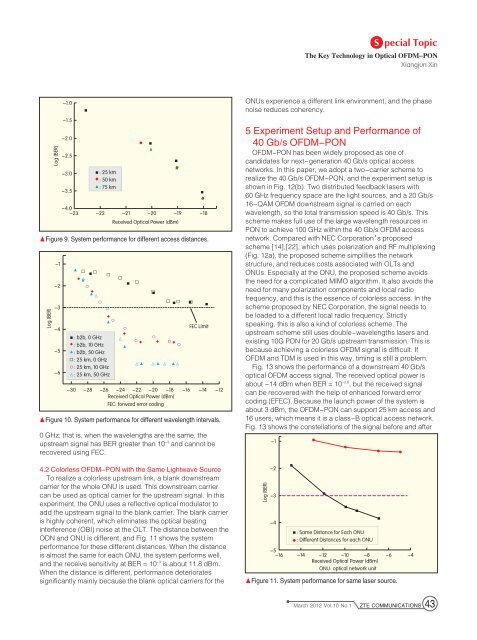ZTE Communications
ZTE Communications
ZTE Communications
Create successful ePaper yourself
Turn your PDF publications into a flip-book with our unique Google optimized e-Paper software.
Log (BER)<br />
-1.0<br />
-1.5<br />
-2.0<br />
-2.5<br />
-3.0<br />
-3.5<br />
-4.0<br />
-23<br />
■<br />
■ : 25 km<br />
●:<br />
50 km<br />
▲:<br />
75 km<br />
-22<br />
-21<br />
Received Optical Power (dBm)<br />
▲Figure 9. System performance for different access distances.<br />
Log (BER)<br />
-1<br />
-2<br />
-3<br />
-4<br />
-5<br />
-6<br />
▲<br />
■ : b2b, 0 GHz<br />
◆:<br />
b2b, 10 GHz<br />
▲:<br />
b2b, 50 GHz<br />
□:<br />
25 km, 0 GHz<br />
○:<br />
25 km, 10 GHz<br />
△:<br />
25 km, 50 GHz<br />
-30<br />
□<br />
◆ ▲ △<br />
□<br />
■<br />
○<br />
◆<br />
▲<br />
△<br />
-28<br />
○<br />
□<br />
△<br />
◆<br />
▲<br />
○<br />
□<br />
■<br />
○<br />
◆<br />
△<br />
▲<br />
-26 -24 -22 -20 -18<br />
Received Optical Power (dBm)<br />
FEC: forward error coding<br />
▲Figure 10. System performance for different wavelength intervals.<br />
0 GHz; that is, when the wavelengths are the same, the<br />
upstream signal has BER greater than 10 -3 and cannot be<br />
recovered using FEC.<br />
4.2 Colorless OFDM-PON with the Same Lightwave Source<br />
To realize a colorless upstream link, a blank downstream<br />
carrier for the whole ONU is used. This downstream carrier<br />
can be used as optical carrier for the upstream signal. In this<br />
experiment, the ONU uses a reflective optical modulator to<br />
add the upstream signal to the blank carrier. The blank carrier<br />
is highly coherent, which eliminates the optical beating<br />
interference (OBI) noise at the OLT. The distance between the<br />
ODN and ONU is different, and Fig. 11 shows the system<br />
performance for these different distances. When the distance<br />
is almost the same for each ONU, the system performs well,<br />
and the receive sensitivity at BER = 10 -3 is about 11.8 dBm.<br />
When the distance is different, performance deteriorates<br />
significantly mainly because the blank optical carriers for the<br />
□<br />
●<br />
■<br />
▲<br />
-20<br />
□■<br />
■<br />
▲●<br />
-19<br />
□<br />
■ □<br />
○<br />
○ ◆ ◆ ○ ◆<br />
○<br />
△ ▲<br />
△ ▲ △ ▲△<br />
-16<br />
■□<br />
■<br />
●▲<br />
-18<br />
■<br />
FEC Limit<br />
-14<br />
-12<br />
S pecial Topic<br />
The Key Technology in Optical OFDM-PON<br />
Xiangjun Xin<br />
ONUs experience a different link environment, and the phase<br />
noise reduces coherency.<br />
5 Experiment Setup and Performance of<br />
40 Gb/s OFDM-PON<br />
OFDM-PON has been widely proposed as one of<br />
candidates for next-generation 40 Gb/s optical access<br />
networks. In this paper, we adopt a two-carrier scheme to<br />
realize the 40 Gb/s OFDM-PON, and the experiment setup is<br />
shown in Fig. 12(b). Two distributed feedback lasers with<br />
60 GHz frequency space are the light sources, and a 20 Gb/s<br />
16-QAM OFDM downstream signal is carried on each<br />
wavelength, so the total transmission speed is 40 Gb/s. This<br />
scheme makes full use of the large wavelength resources in<br />
PON to achieve 100 GHz within the 40 Gb/s OFDM access<br />
network. Compared with NEC Corporation’s proposed<br />
scheme [14],[22], which uses polarization and RF multiplexing<br />
(Fig. 12a), the proposed scheme simplifies the network<br />
structure, and reduces costs associated with OLTs and<br />
ONUs. Especially at the ONU, the proposed scheme avoids<br />
the need for a complicated MIMO algorithm. It also avoids the<br />
need for many polarization components and local radio<br />
frequency, and this is the essence of colorless access. In the<br />
scheme proposed by NEC Corporation, the signal needs to<br />
be loaded to a different local radio frequency. Strictly<br />
speaking, this is also a kind of colorless scheme. The<br />
upstream scheme still uses double-wavelengths lasers and<br />
existing 10G PON for 20 Gb/s upstream transmission. This is<br />
because achieving a colorless OFDM signal is difficult. If<br />
OFDM and TDM is used in this way, timing is still a problem.<br />
Fig. 13 shows the performance of a downstream 40 Gb/s<br />
optical OFDM access signal. The received optical power is<br />
about -14 dBm when BER = 10 -2.6 , but the received signal<br />
can be recovered with the help of enhanced forward error<br />
coding (EFEC). Because the launch power of the system is<br />
about 3 dBm, the OFDM-PON can support 25 km access and<br />
16 users, which means it is a class-B optical access network.<br />
Fig. 13 shows the constellations of the signal before and after<br />
Log (BER)<br />
-1<br />
-2<br />
-3<br />
-4<br />
-5<br />
-16<br />
■<br />
-14<br />
●<br />
■ : Same Distance for Each ONU<br />
●:<br />
Different Distances for each ONU<br />
-12 -10 -8<br />
Received Optical Power (dBm)<br />
ONU: optical network unit<br />
▲Figure 11. System performance for same laser source.<br />
■<br />
●<br />
■<br />
■<br />
March 2012 Vol.10 No.1 <strong>ZTE</strong> COMMUNICATIONS 43<br />
●<br />
■<br />
-6<br />
●<br />
-4

















